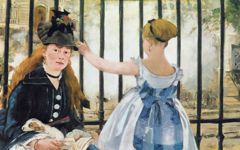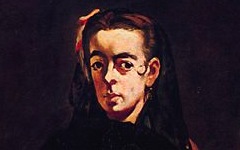Manet’s Woman with a Jug (1858-60)

Manet, Woman with a Jug (1858-60) Oil on canvas. Ordrupgaard, Copenhagen, Denmark.
Click image to enlarge.
This 1858 painting by Manet of his future wife, Suzanne Leenhof, demonstrates how even at this early stage of his career he was pursuing a consistent theme that his admirers have never recognized: the depiction of a creative moment in his own mind.
Although clearly intended to resemble a rather old-fashioned genre scene of a woman in front of a window, it nevertheless contains elements that frustrate such a reading. The window, for instance, with its gold frame is ambiguous because it resembles a painting and the scene "outside" is painted in a quite different style, more like a painting than a real view.1
Click next thumbnail to continue
It has always been known that Manet highly admired Velazquez's Las Meninas but no-one has noted how many of his figures are based on Velazquez's.2 Here Suzanne takes the pose of the artist himself, with one hand diagonally above the other, both arms bent. She stands in front of her canvas; Velazquez behind his. Suzanne, we can now see, is a visual metaphor for an "artist" as she pours water into a bowl, an iconic action with religious and mystical overtones. Sensitive artists would have recognized her for what she was; all others would see a genre scene.
Click next thumbnail to continue
To strengthen the identification, Manet formed Suzanne's fingers into the letter M and put a gold ring on her finger. The ring, always interpreted as a promise of future marriage to Suzanne (they did not wed until four years later), is really a symbol of his own mystical identification with Velazquez, like St. Catherine's mystical marriage with Christ. Married, man and woman, Manet's mind is represented as androgynous.
Ever since Manet's own lifetime his art has been criticized as inconsistent because no-one other than artists could see that all his paintings are an allegory of the creative moment. Yet his meaning, which we viewers are now able to perceive, never wavers.
More Works by Manet
See how smoke and mirrors turn the outside of Manet's studio into the inside

Manet’s The Railway (1873)
Notes:
1. Rolf Laessøe has alredy noted the difference in facture and described the view as "a painting-within-a-painting". Laessøe, "Edouard Manet's Le Déjeuner sur l'Herbe as a Veiled Allegory of Painting, Artibus et Historiae 26, 2005, p. 199
2. Carol Armstrong, who has noted how many of Manet's figures have arms bent in a similar fashion, links them to Velazquez's Portrait of Philip IV in Hunting Costume. She does not recognize, though, that Philip IV is also a metaphoric "artist" which is why Manet used the king's figure alone in some portraits or in combination with Velazquez's. By using both, he merges artistic and royal significance into the same figure, signifying his own mind as both regal and masterful. It has long been recognized that Manet used a remarkable number of sources in a single image; this is the reason. More sources, more meaning. See Armstrong, Manet Manette (Yale University Press) 2002, pp. 85-7
Original Publication Date on EPPH: 05 Nov 2010. | Updated: 0. © Simon Abrahams. Articles on this site are the copyright of Simon Abrahams. To use copyrighted material in print or other media for purposes beyond 'fair use', you must obtain permission from the copyright owner. Websites may link to this page without permission (please do) but may not reproduce the material on their own site without crediting Simon Abrahams and EPPH.




